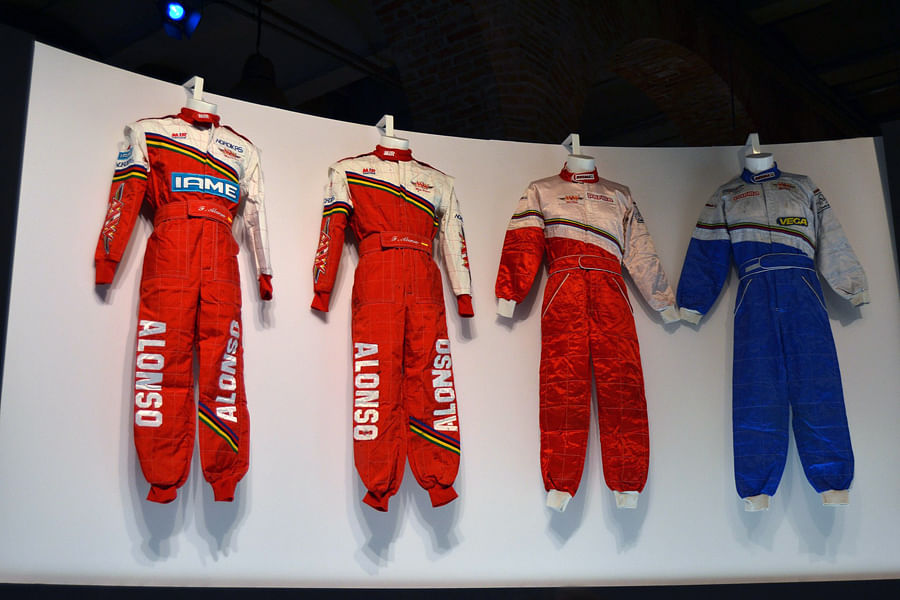
The modern Formula 1 car is built to absorb force in case of an accident and keep the driver safe.
But the driver is still exposed to dangers like getting hit by flying debris or injury due to fire. An impact could also cause serious injury to the head or neck. Modern driver gear is designed to minimise chance of injury.
The colourfully designed overalls are more than just sporting gear. F1 cars generate a lot of heat. Consider the situation when there is a fuel leak. Hot fuel on hot engine parts is going to be disaster.
Consider the situation when refuelling was allowed in F1, there have been instances in which fuel spilt on the car has gone up in flames. In either of these circumstances, the driver is in danger of severe burns.
In 1975, the International Automobile Federation (FIA) brought out standards for fireproof clothing. In 1979, Niki Lauda, Carlos Reutemann and Mario Andretti became the first to compete in five-layer fireproof overalls, the same used by US space agency NASA. It raised the safety level for drivers in competition but it was a five-layer suit that was also heavy. This would have meant a lot of discomfort for the drivers.
Safety clothing technology has moved far ahead since the late 70s. Drivers nowadays wear suits made of Nomex, which is a fire-resistant and lightweight fibre. These suits are tested with open flames at about 400 degree Celsius. It should also be able to resist ignition for 10 seconds and only then is it allowed for use in competition. The pit crew also wear suits made of this material. These suits are breathable and allow sweat to dry.
Drivers and pit crew wear suits that are made up of two to four layers of Nomex. The suit is put through 15 washing and drying cycles before being tested. This suit is then put through a punishing test in which it has to remain intact at temperatures of about 800 degree Celsius. Also, the inside of the suit must not cross 41 degree Celsius for at least 11 seconds. This is to ensure the wearer is not affected by the heat in case of a fire. Even the zipper and thread used to sew it should be able to withstand these high temperatures. The driver also wears fireproof underwear and balaclava under the helmet.
Wearing this suit, a driver can survive for 11 seconds at a temperature of 840 degree Celsius.
FIA rules further say that the epaulette-like pieces on the shoulder should be capable of supporting the combined weight of the driver and the seat. This is because the marshals should be able to remove the driver and seat as one. This is done to avoid aggravating any injury the driver may have sustained during a collision or crash.
Nomex is also used to make the driver’s gloves. They are thin and have leather stitched on to the palm area so as to give a good feel of the steering. The driver’s leather shoes are also fireproof.
Helmets
Helmets were made mandatory from the 1953 Formula 1 season. However, the design and safety of today’s helmets are far better. This is important since head and neck injuries are most common for drivers.
Modern F1 helmets are just around 1.2 Kg, but very strong. They need to be light because unnecessary weight will add to the G-forces that the driver will experience while accelerating, braking and cornering.
FIA standard helmets must be used and these are subjected to tough deformation and fragmentation tests. They are made largely of carbon fibre, polyethylene and fire-resistant aramid.
The construction is in layers. The outer shell is fibre-reinforced resin on carbon fibre. There is a layer of aramid (Kevlar) and then a softer, deformable layer made from polyethylene. This is then covered with Nomex.
The visor is made of a special clear polycarbonate, which has excellent impact protection, flame resistance and visibility. Drivers use tinted visors and the insides are coatec with anti-fogging chemicals.
HANS
The Head and Neck Support (HANS) is a device that prevents stretching of the vertebrae and keeps the driver’s head from hitting the steering wheel.
A carbon fibre shoulder collar is secured to the driver’s safety belt and also fastened to the helmet with elastic straps.
It is said that in tests, the HANS reduces head motion by 44 per cent in case of an accident.
Information source: www.formula1.com